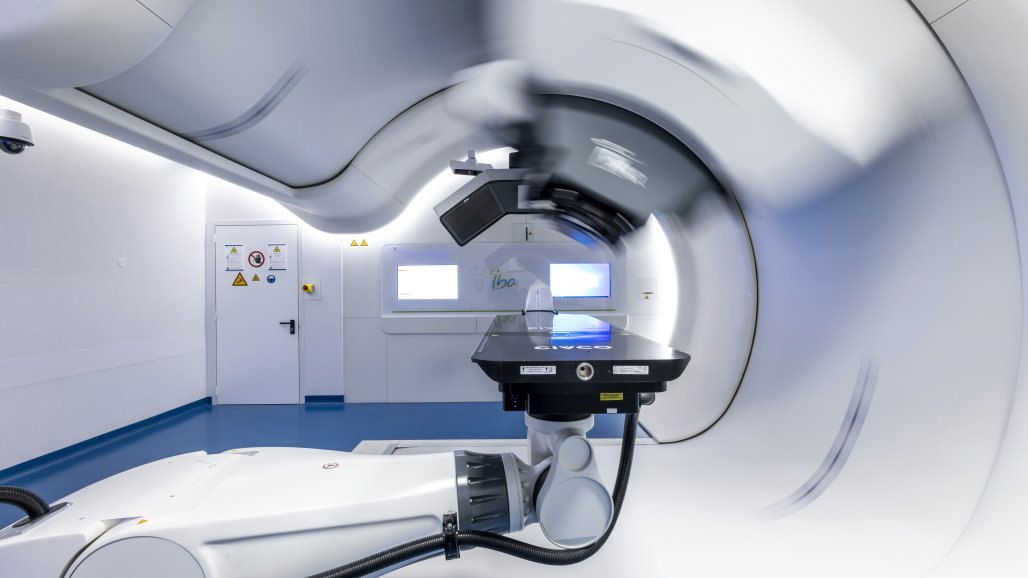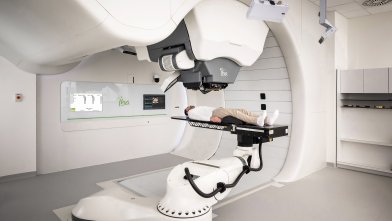A Medical Physicist’s Perspective on DynamicARC
Proton Arc Therapy with DynamicARC* is on the verge of transforming the landscape of proton therapy and cancer care. In this blog, Xuanfeng (Leo) Ding, PhD, the Lead Proton Physicist at Corewell Health’s William Beaumont University Hospital Proton Therapy Center, explains how DynamicARC* will revolutionize the proton therapy field with its advanced capabilities, representing the next leap forward in cancer treatment technology.
Understanding DynamicARC treatment modality
Developed through a collaborative effort between William Beaumont Hospital IBA, and other clinical and industrial partners, DynamicARC offers a new approach that rotates the gantry while delivering treatment, achieving submillimeter accuracy.1 By allowing the gantry to rotate, it provides more degrees of freedom compared to traditional methods, such as multi-field intensity-modulated proton therapy (IMPT). As Dr Ding explains, partial arc or a full arc may be used to optimize the placement of spots and energy layers within the treatment area, for a much sharper dose fall-off.2
Enhanced dose conformity with DynamicARC
Dr Ding also highlights that of the standout features of DynamicARC therapy is its ability to achieve high dose conformity. This is particularly important in reducing normal tissue toxicity, which is a critical concern in cancer treatment with radiotherapy.3 Published research has shown that DynamicARC can benefit a variety of disease sites, including brain tumors4,5, head and neck cancers6, lung7,8, and prostate cancers9. By providing sharper treatment, DynamicARC therapy will benefit a wide array of disease sites.
Discover here more information on the clinical indications that may benefit from DynamicARC.
Improving patient quality of life
Dr. Leo Ding emphasizes that the advantages of DynamicARC extend beyond technical specifications. According to Dr. Ding, “of the most compelling benefits is its potential to improve the quality of life for patients”. As it enhances dose conformity and high dose sparing compared to IMPT technique currently used, DynamicARC has the potential to reshape cancer treatment and the current proton therapy landscape.9
Conclusion
In conclusion, Proton Arc Therapy with DynamicARC stands at the forefront of cancer treatment innovation. Its ability to deliver precise, conformal radiation while minimizing dose to the surrounding normal tissues has the potential to improve patient outcomes and quality of life, making it an invaluable tool in the fight against cancer.
Discover how DynamicARC can help deliver sharper, faster and simpler treatments here.
Notes
Disclaimer: The statements of the healthcare professional included in this testimonial reflect only his opinion and personal experience. They do not necessarily reflect the opinion of any institution with whom he is affiliated or IBA.
* DynamicARC is the registered brand of IBA’s Proton Arc therapy solution which is currently under research and development. DynamicARC will be available for sale when regulatory clearance is received. Due to a continuous research and development program, IBA reserves the right to make changes in design, technical descriptions, and specifications of its products without prior notice. Some features are under development and may be subject to review by competent authorities.
References
- Li, X. et al. The first prototype of spot-scanning proton arc treatment delivery. Radiotherapy and Oncology. 2019;137130–136. doi: 10.1016/J.RADONC.2019.04.032
- de Jong B et al. Proton arc therapy increases the benefit of proton therapy for oropharyngeal cancer patients in the model-based clinic, Radiotherapy and Oncology (2023).
- de Jong B et al. Both S. Spot scanning proton arc therapy reduces toxicity in oropharyngeal cancer patients. Med Phys. 2023 Mar;50(3):1305-1317.
- Chang S et al. Redefine the Role of Spot-Scanning Proton Beam Therapy for the Single Brain Metastasis Stereotactic Radiosurgery. Front Oncol. 2022 May 19;12:804036. doi: 10.3389/fonc.2022.804036. PMID: 35664795; PMCID: PMC9160604.
- Ding X et al Improving dosimetric outcome for hippocampus and cochlea sparing whole brain radiotherapy using spot-scanning proton arc therapy. Acta Oncol. 2019 Apr;58(4):483-490.
- Liu G et al. Improve the dosimetric outcome in bilateral head and neck cancer (HNC) treatment using spot-scanning proton arc (SPArc) therapy: a feasibility study. Radiat Oncol. 2020 Jan 30;15(1):21.
- Li X, Kabolizadeh P, Yan D, Qin A, Zhou J, Hong Y, Guerrero T, Grills I, Stevens C, Ding X. Improve dosimetric outcome in stage III non-small-cell lung cancer treatment using spot-scanning proton arc (SPArc) therapy. Radiat Oncol. 2018 Feb 27;13(1):35. doi: 10.1186/s13014-018-0981-6. PMID: 29486782; PMCID: PMC6389253.
- Liu G et al. Lung Stereotactic Body Radiotherapy (SBRT) Using Spot-Scanning Proton Arc (SPArc) Therapy: A Feasibility Study. Front Oncol. 2021 Apr 22;11:664455.
- Ding X et al. Have we reached proton beam therapy dosimetric limitations? - A novel robust, delivery-efficient and continuous spot-scanning proton arc (SPArc) therapy is to improve the dosimetric outcome in treating prostate cancer. Acta Oncol. 2018 Mar;57(3):435-437.




